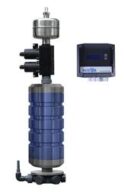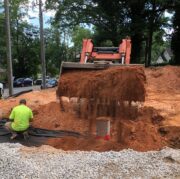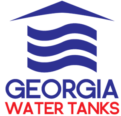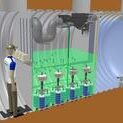Reusing Stormwater
We define stormwater as rain that has landed or run off parking lots, roads, lawns, green roofs, or other surfaces that would allow a continuous source of pollution to dissolve or suspend in the water. This is a contrast to rainwater, where only the first few minutes of runoff will have leaves or "dissolved organics."
Stormwater Collection Tanks
Stormwater tanks can be fiberglass, concrete, or plastic tanks. Any underground infiltration chamber can become a tank, with the addition of an impervious liner. For commercial projects, it's common for cistern volumes to be discounted by 25%. This is because the tanks do not always empty between rainfall events.


For more information on sizing tanks for code compliance see
Uses
Top Recommendation – Irrigation
The best use for stormwater is irrigation. Irrigation requires no additional treatment, and irrigating is a proven method of removing suspended and dissolved pollutants, without damaging the plants themselves. A 1 acre parking lot is the right size collection surface for 1 acre of turf or annuals, or 2 acres of bushes or trees.
Cooling Tower Makeup & Toilet Flushing
For cooling tower makeup and toilet flushing uses, the treatment needs to be capable of removing a larger amount of sediment. Also, sediment particles in stormwater are smaller than in rainwater, so typical rainwater filters won't clean up the water as well. Anyone who has tried to reuse green roof runoff knows that the water doesn't look quite right. But more importantly, we can expect some amount of oil and grease, and this could be a problem in the plumbing.
While stormwater is more contaminated than rainwater, it's substantially LESS dirty than grey water.
AQUALOOP treatment membrane pods (left) are field-installed in a collection/treatment tank (don't worry, Georgia Water Tanks will supervise the installation). The tank can be supplied by Georgia Water Tanks, or by others. Treated water is pumped to a second tank automatically. Additional treatment, such as UV, carbon, or chlorine, can be included if desired, but is not required. Water is then available on-demand, for uses such as cooling tower makeup, toilet flushing, etc. A second pump delivers the treated water to the fixtures. Automatic controls supply standby water from up to 2 additional sources.

Aqualoop Stormwater Treatment Sizing
Gray Water System Maintenance
It's important to note that stormwater management devices, whether reusing the water or not, are generally NOT self-cleaning. All that sand and dust has to go somewhere, when the rain washes your parking lot clean! Average amounts are 75#/year/acre for a residence, and 200#/year/acre for commercial properties (source).
This should be inspected annually and must be pumped from the SedimenTrap or other catchment device as needed.


